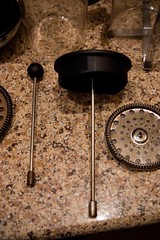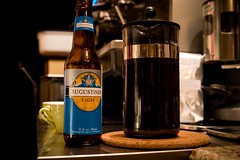Trolling the Coffeed forums, we came across
this post, about how to make a 'ghetto Clover' using a French Press in reverse. Instead of putting the grounds on the bottom and pressing down, put the grounds on top of the screen and pull up, supposedly creating a cleaner cup, akin to a Clover. Hearing that we could replicate a cup of coffee from an $11,000 machine using tools we already have, we were interested and had to try it out.

First there were some problems to overcome. Many of the replies to the post mention that the French Press has a limited range and that some of the water at the bottom doesn't get a chance to brew. Using our McGyver-like tactics we contemplated how to construct a longer dowel rod to get the screen to the bottom of the French Press. While fabricating our own dowel rod would be awesome, the solution actually turned out to be much simpler. We have several Bodum French Presses and just unscrewed the dowel rod from a larger French Press and attached it to the lid and screen from a smaller one. Voila! Just like that we extended the rod and didn't even have to take any pills mentioned on late night TV infomercials!

Once we fixed this problem, the other issue was how we should get the water in there. After some trial and error, we found the best way is to put the screen (and grounds) at the bottom of the French Press and pour water over it through the spout and swirl the French Press to get all the grounds wet.

While this produced a great cup, I'd like to continue working to improve the reverse French Press. I'd like to use a finer grind for this reverse method, as the Clover tends to use a finer grind to achieve a fast brewing time. Sweet Maria's sells a
nylon filter that could allow for a finer grind to be used. Another area of interest is how much the vacuum effect of the Clover contributes to the cup and how it could be implemented. Hopefully this is only the start of the 'Ghetto Clover' and that BFCAT and others will contribute to new designs and new ideas. Any ideas on how it could be improved?
 First there were some problems to overcome. Many of the replies to the post mention that the French Press has a limited range and that some of the water at the bottom doesn't get a chance to brew. Using our McGyver-like tactics we contemplated how to construct a longer dowel rod to get the screen to the bottom of the French Press. While fabricating our own dowel rod would be awesome, the solution actually turned out to be much simpler. We have several Bodum French Presses and just unscrewed the dowel rod from a larger French Press and attached it to the lid and screen from a smaller one. Voila! Just like that we extended the rod and didn't even have to take any pills mentioned on late night TV infomercials!
First there were some problems to overcome. Many of the replies to the post mention that the French Press has a limited range and that some of the water at the bottom doesn't get a chance to brew. Using our McGyver-like tactics we contemplated how to construct a longer dowel rod to get the screen to the bottom of the French Press. While fabricating our own dowel rod would be awesome, the solution actually turned out to be much simpler. We have several Bodum French Presses and just unscrewed the dowel rod from a larger French Press and attached it to the lid and screen from a smaller one. Voila! Just like that we extended the rod and didn't even have to take any pills mentioned on late night TV infomercials! Once we fixed this problem, the other issue was how we should get the water in there. After some trial and error, we found the best way is to put the screen (and grounds) at the bottom of the French Press and pour water over it through the spout and swirl the French Press to get all the grounds wet.
Once we fixed this problem, the other issue was how we should get the water in there. After some trial and error, we found the best way is to put the screen (and grounds) at the bottom of the French Press and pour water over it through the spout and swirl the French Press to get all the grounds wet. While this produced a great cup, I'd like to continue working to improve the reverse French Press. I'd like to use a finer grind for this reverse method, as the Clover tends to use a finer grind to achieve a fast brewing time. Sweet Maria's sells a nylon filter that could allow for a finer grind to be used. Another area of interest is how much the vacuum effect of the Clover contributes to the cup and how it could be implemented. Hopefully this is only the start of the 'Ghetto Clover' and that BFCAT and others will contribute to new designs and new ideas. Any ideas on how it could be improved?
While this produced a great cup, I'd like to continue working to improve the reverse French Press. I'd like to use a finer grind for this reverse method, as the Clover tends to use a finer grind to achieve a fast brewing time. Sweet Maria's sells a nylon filter that could allow for a finer grind to be used. Another area of interest is how much the vacuum effect of the Clover contributes to the cup and how it could be implemented. Hopefully this is only the start of the 'Ghetto Clover' and that BFCAT and others will contribute to new designs and new ideas. Any ideas on how it could be improved?

3 comments:
Ok, call me crazy, but maybe if you could get more of a seal on the top of the glass body, you could approximate the vacuum properties of the clover, not to mention that you would need some kind of pressure to extract from a finer grind in a shorter amount of time.
Aaah! Fun!!
Compressed air. Just kidding.
I'm digging the blog. Good work!
This one got me thinkin, Russ. Maybe it's because it combines my love of coffee with my love of vacuum tubes. Here's my take on it.
I am not entirely familiar with the operation of a Clover, however, I can infer based on the parameters of the reversed french press what we're talking about. If the Clover uses some sort of vacuum effect, what we're really talking about is a pressure differential across a wad of wet grounds. In an espresso machine, a positive force is applied over the grounds, dissipating into the atmosphere on the other side. Here however, you have but one Bar (roughly 14psi) at your disposal, on the steadily positive side of the grounds, and a vacuum (at least when measured in an instant at t=0) on the other. While that may sound like it limits us, we are able, by pulling out farther (or with a time-continuous system such at this, faster) in order to increase the change in the "SI" part of "P/SI". Square inches, that is. Elongating the tube of negative pressure in the press (we should really call it a "suck") increases one spatial dimension linearly, resulting in a proportional increase in P.
Here's what this all means. If you figure out the actual pressure differential in a Clover machine in pounds, you can recreate the same differential with your ghetto press (or suck), by calculating the correct amount of time it should take to get the dowel from completely down to completely up.
You would need no external pump, compressor, or vacuum in order to create the correct differential. Only a stopwatch and some elbow grease.
P.S. You really ought to use a Bodum press for this task. They are the only ones that I know of who use borosilicate glass, which is exceptionally strong.
Post a Comment